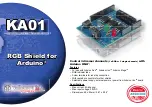
I2C Module Registers
1027
SPRUH22I – April 2012 – Revised November 2019
Copyright © 2012–2019, Texas Instruments Incorporated
C28 Inter-Integrated Circuit Module
Table 14-10. I2C Status Register (I2CSTR) Field Descriptions (continued)
Bit
Field
Value
Description
8
AD0
Address 0 bits
0
AD0 has been cleared by a START or STOP condition.
1
An address of all zeros (general call) is detected.
7-6
Reserved
0
These reserved bit locations are always read as zeros. A value written to this field has no effect.
5
SCD
Stop condition detected bit. SCD is set when the I2C sends or receives a STOP condition. The I2C
module delays clearing of the I2CMDR[STP] bit until the SCD bit is set.
0
STOP condition not detected since SCD was last cleared. SCD is cleared by any one of the
following events:
• I2CISRC is read by the CPU when it contains the value 110b (stop condition detected). Emulator
reads of the I2CISRC do not affect this bit.
• SCD is manually cleared. To clear this bit, write a 1 to it.
• The I2C module is reset.
1
A STOP condition has been detected on the I2C bus.
4
XRDY
Transmit-data-ready interrupt flag bit. When not in FIFO mode, XRDY indicates that the data
transmit register (I2CDXR) is ready to accept new data because the previous data has been copied
from I2CDXR to the transmit shift register (I2CXSR). The CPU can poll XRDY or use the XRDY
interrupt request (see
). When in FIFO mode, use TXFFINT instead.
0
I2CDXR not ready. XRDY is cleared when data is written to I2CDXR.
1
I2CDXR ready: Data has been copied from I2CDXR to I2CXSR.
XRDY is also forced to 1 when the I2C module is reset.
3
RRDY
Receive-data-ready interrupt flag bit. When not in FIFO mode, RRDY indicates that the data receive
register (I2CDRR) is ready to be read because data has been copied from the receive shift register
(I2CRSR) to I2CDRR. The CPU can poll RRDY or use the RRDY interrupt request (see
). When in FIFO mode, use RXFFINT instead.
0
I2CDRR not ready. RRDY is cleared by any one of the following events:
• I2CDRR is read by the CPU. Emulator reads of the I2CDRR do not affect this bit.
• RRDY is manually cleared. To clear this bit, write a 1 to it.
• The I2C module is reset.
1
I2CDRR ready: Data has been copied from I2CRSR to I2CDRR.
2
ARDY
Register-access-ready interrupt flag bit (only applicable when the I2C module is in the master
mode). ARDY indicates that the I2C module registers are ready to be accessed because the
previously programmed address, data, and command values have been used. The CPU can poll
ARDY or use the ARDY interrupt request (see
0
The registers are not ready to be accessed. ARDY is cleared by any one of the following events:
• The I2C module starts using the current register contents.
• ARDY is manually cleared. To clear this bit, write a 1 to it.
• The I2C module is reset.
1
The registers are ready to be accessed.
In the nonrepeat mode (RM = 0 in I2CMDR): If STP = 0 in I2CMDR, the ARDY bit is set when the
internal data counter counts down to 0. If STP = 1, ARDY is not affected (instead, the I2C module
generates a STOP condition when the counter reaches 0).
In the repeat mode (RM = 1): ARDY is set at the end of each byte transmitted from I2CDXR.
1
NACK
No-acknowledgment interrupt flag bit. NACK applies when the I2C module is a transmitter (master
or slave). NACK indicates whether the I2C module has detected an acknowledge bit (ACK) or a no-
acknowledge bit (NACK) from the receiver. The CPU can poll NACK or use the NACK interrupt
request (see
0
ACK received/NACK not received. This bit is cleared by any one of the following events:
• An acknowledge bit (ACK) has been sent by the receiver.
• NACK is manually cleared. To clear this bit, write a 1 to it.
• The CPU reads the interrupt source register (I2CISRC) and the register contains the code for a
NACK interrupt. Emulator reads of the I2CISRC do not affect this bit.
• The I2C module is reset.
1
NACK bit received. The hardware detects that a no-acknowledge (NACK) bit has been received.
Note: While the I2C module performs a general call transfer, NACK is 1, even if one or more slaves
send acknowledgment.
















































